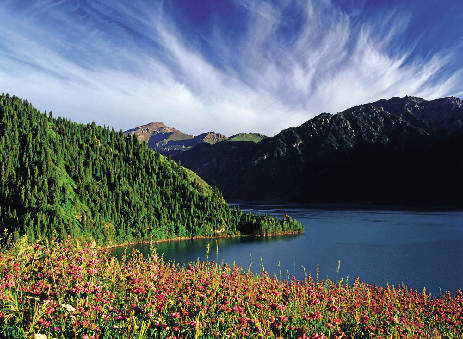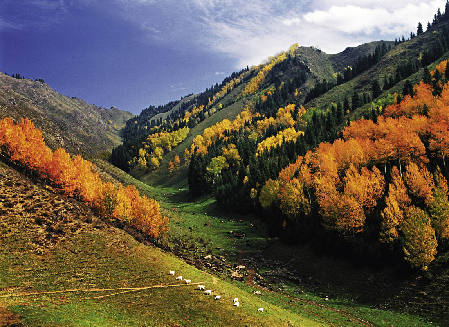Heavenly Lake
By DONG CHUNYAN
TIANCHI (Heavenly Lake) is in Fukang City, Changji Hui Autonomous Prefecture, just 68 kilometers from Urumqi, capital city of Xinjiang Uygur Autonomous Region. The 548-square-kilometer Tianchi Scenic Zone is divided into eight areas, consisting of the lake itself and the mountains and valleys surrounding it. All have ready access to highways and telecommunication networks. Visitors to the zone’s 38 sightseeing spots scattered throughout 15 scenic settings can explore its vistas of typical arid Northwest China mountain scenery – snow-capped mountains, glaciers, and alpine lakes.
Aesthetics and Scientific Research
The Tianchi Scenic Zone exemplifies Northwest China mountain scenery, and also that of the arid Eurasian Continent hinterland. Just 80 kilometers from north to south, scenery in the zone displays dramatic contrasts. Its complete vertical mountainous landscape belt ranges from alpine ice and snow-capped mountains to subalpine meadows, mountainous forests and upland meadows, to desert. Such a complete geomorphologic landscape and vegetation vertical zone spectrum being extremely rare anywhere in the world, the Tianchi Scenic Zone is of considerable scientific value.
Tianchi Lake is halfway up the Tianshan mountain range, which originated in the neotectonics era and evolved over eons of natural geological history. A legacy of the Quarternary Glacier, the geological features of the Tianchi Scenic Zone include glaciers, desert, Gobi, Yardang landforms, and ancient sea and continental fossils. It offers an ideal environment for research on the Tianshan Mountain tectonic belt.
The lake’s practical significance first came to light in 1783. That year General Ming Liang of Urumqi climbed the mountain to carry out a field survey on water resources. He then channeled water from Tianchi Lake to farmland in Fukang. A hundred years later, groups of scientists and explorers from Russia, France, Sweden and Germany came to the lake. But it was not until the 1930s that Chinese archaeologist Xu Bingchang and geologist Yuan Fuli discovered the origins of the lake and its geological landforms.
|
|
|
A mountain valley in late fall. |
Legends
The 4.9-square-kilometer gourd-shaped Tianchi is a typical alpine glacial lake with an elevation of 1,910 meters above sea level. Along with its natural scenery of falls and ponds, the lake also abounds in ancient myths and legends that are a mixture of pre-Qin Dynasty (220-206 BC) imagination and holy fables.
The earliest tales go back more than 2,000 years. Several literary works tell of how the Queen Mother of the West encountered King Mu of the Western Zhou Dynasty, who reigned from 976 to 922 BC, in Yaochi, the original name of Tianchi. According to Chinese legends, Yaochi was a lake in the summer palace garden of the immortals’ earthly residence. There the celestial beings enjoyed secular delights, wine and music. The Queen Mother of the West would often bathe in the lake with other female celestials. Tianchi Lake is consequently synonymous with the immortals and spirituality prevalent in Chinese culture.
 |
|
Spring-awakened nature. |
Enchanting Views
The romance of the Queen Mother of the West, known in every local household, is enshrined in a temple east of Tianchi Lake. Originally a Buddhist nunnery built in 1923, the temple was destroyed in 1944 and reconstructed in 1999 by the Urumqi Daocheng Industrial Co., Ltd. Covering a total area of 2,000 square meters, the main hall is dedicated to the Queen Mother of the West, the eastern hall to the Avalokitesvara, and the western hall to Taoist celestial Lü Dongbin and the late Living Buddha Jigong. Over the years the temple has drawn droves of Taoists from both China and abroad.
Besides the temple, one of the most visited spots in the Tianchi Scenic Zone is Mount Bogda, whose stunning natural features include glaciers and canyons, winding brooks and falls, and dense forests and meadows. Bogda’s rock paintings, the highest-altitude of their kind, are famed for their rich content, quantity, and excellent state of preservation. In 1990, Mount Bogda became part of the UNESCO Man and the Biosphere Programme (MAB), so acting as a key base in China’s arid area for MAB international cooperation and exchanges.
Among the 10 peaks surrounding Tianchi Lake, Maya Mountain, with an elevation of 3,056 meters above sea level, is the tallest. Around five kilometers in length, the mountain is one of the world’s grandest stone forest landforms. The large numbers of stones on the mountain resembling people and animals have become part of the local Hazakh people’s folklore. One of their many tales regards one such stone as a master standing on the mountaintop keeping watch over his cattle and sheep as they graze. In summer, abundant rainfall turns the mountain green, and a fern called Festuca ovina grows everywhere. The Hazakh people hence also call the peak Festuca ovina mountain.
Denggan (lamp pole) Mountain, on the west side of Tianchi Lake, is, at an altitude of 2,718 meters, the second highest peak. Stretching from north to south, the mountain body is three kilometers long and two kilometers wide. On top of the main peak stand three giant stalagmites that were formed from volcanic rocks and which feature crevices from centuries of weathering. These halberd-like rocks are also called “rocks holding up the sky.”
The topmost peak offers a bird’s-eye view of Tianchi Lake as it reflects the setting sun, and also of lofty Bogda Peak in the south. It is even possible to see the distant twinkling city lights of Urumqi as the sky darkens.
Preserve Natural Beauty
In 2003, the Tianchi Lake Administrative Committee, under the guidance of the governments of Fukang City and Changji Hui Autonomous Prefecture, set its sights on preserving local natural resources and developing a world-class scenic zone. The “ecological Tianchi” concept was raised as one of five development dimensions, the other four being culture, trustworthy services, digitalized management, and ice and snow-themed tourism.
Since then, ecological preservation has been regarded as fundamental. Investment in this respect totals RMB 600 million. Among the various projects the administrative committee launched was closing off hills for reforestation, forest plantation, natural forest preservation, silt cleaning, and comprehensive geological hazard management, all of which contributed to an improved environment.
After years of exploration, the committee has identified the development core – nature preservation. To this end, it encouraged farmers, herdsmen, and miners to move out of Sangong River Valley and Shuimo River Valley, so to advance ecological restoration within the scenic zone and upgrading of the industrial structure. Relocated locals have mainly taken up work in agriculture, tourism, animal husbandry, and industrial sectors.
Since 2006, the administrative committee has invited top tourism planning and design institutes, such as Southeast University, Beijing Davost, and Guangdong New Space, to draft as many as 14 plans. These include the overall plan for the scenic zone, and that for upgrading tourism products. All emphasize preservation and development when utilizing natural resources in a reasonable and scientific way. Under this guidance, the administrative committee has raised RMB 1.6 billion to renovate more than 40 items of infrastructure, including Highway S111, Fushou Taoist Temple, the international ski resort, and the tourism distribution center.
Culture, the Soul of Tourism
This concept has been fully embodied during tourism development. Take the legend of the Queen Mother of the West as an example. The administrative committee worked with various social research institutes to pinpoint the cultural meaning of the legend from multiple angles and levels. It later co-published with the Chinese Academy of Social Sciences the six-volume Research Collection of the Culture of the Queen Mother of the West, and also published a seven-book series on the cultural legacy of Tianchi Lake. Over the past few years, the committee organized the first Queen Mother of the West themed festival and the first academic forum on related folklore and legends. It also established a research center in this regard under the guidance of the China Folklore Society, and has moreover held 11 snow festivals to build its winter tourism brand.
The Tianchi Lake Scenic Zone is the first in Xinjiang to receive the ISO9001 (quality management), ISO14000 (environment management), and OSHMS18000 (professional safety health management) certification. Fully integrating management standards into its daily work, the zone has won a collection of awards, among them the National Tourism Bureau title of National Outstanding Tourist Areas. It was also one of the first scenic areas to receive a 5A top quality ranking.
Meanwhile, the committee has accelerated the pace of building a digital and smart system for the zone. Detailed measures include setting up a portal website, installing remote sensing and video monitoring systems for real-time monitoring of key areas and areas vulnerable to hazards, establishing a unified service platform for tourists’ complaints and suggestions, and a control center for emergency scheduling and vehicle management. The Ministry of Housing and Urban-Rural Development has listed the zone among the first 24 pilot scenic areas to construct monitoring information systems.
In 2015, the National Tourism Bureau awarded the Tianchi Lake Scenic Zone for its trustworthy pricing system. From January to late November 2015, the scenic zone received about 1.892 million visitors, a 9.5 percent increase over the corresponding period of the previous year. It thus realized a total income of RMB 1.27 billion, 14 percent more than in 2014, RMB 101 million of which is attributable to an 85 percent spike in ticket sales. The zone’s picturesque, enchanting scenery will undoubtedly continue to attract growing numbers of visitors from around the world.

